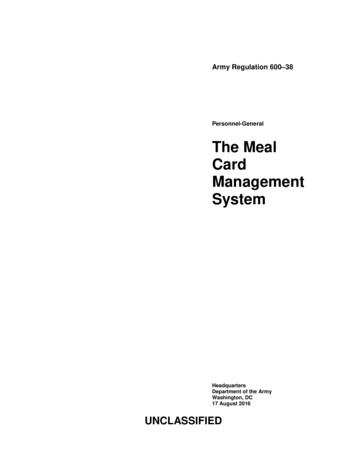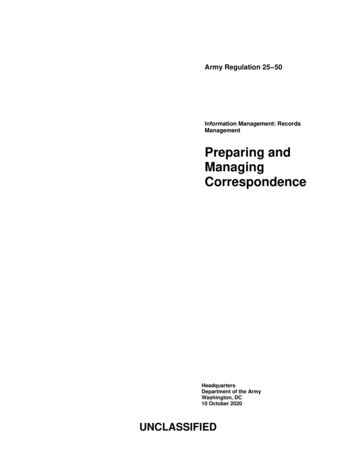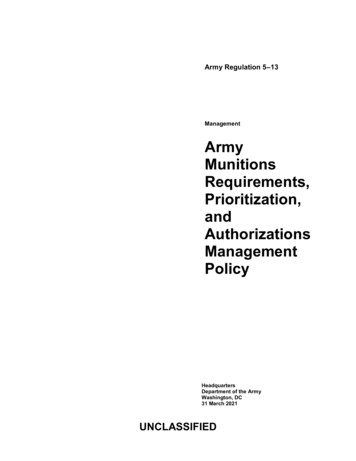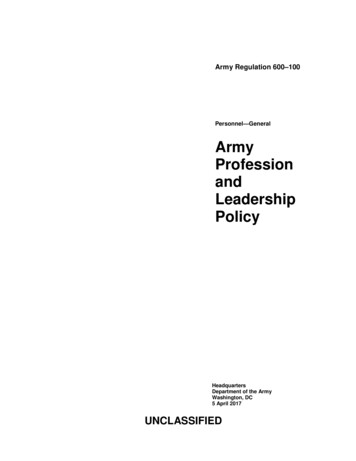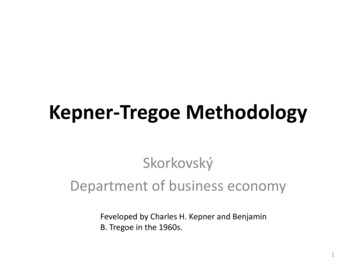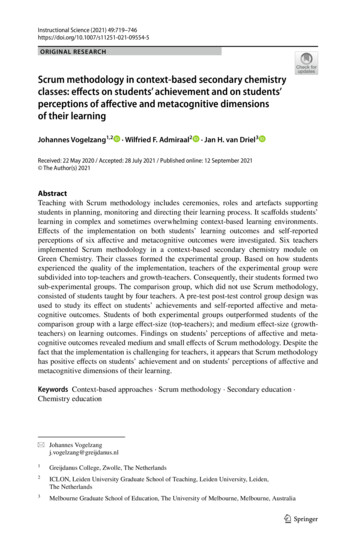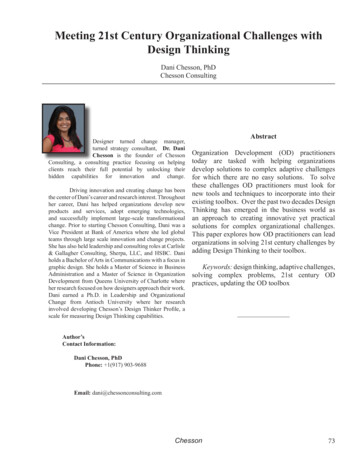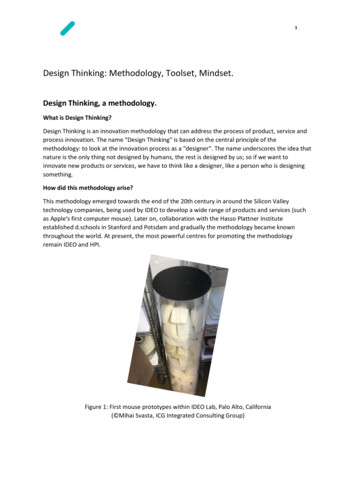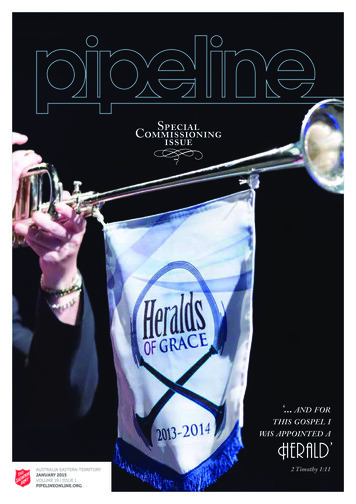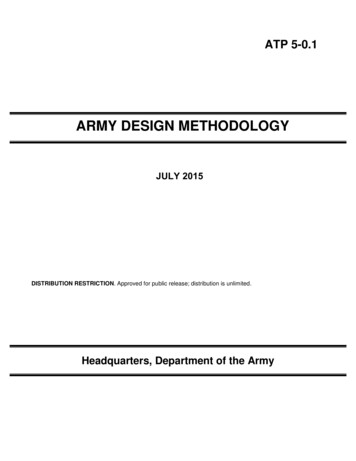
Transcription
ATP 5-0.112ARMY DESIGN METHODOLOGY3456JULY 2015DISTRIBUTION RESTRICTION. Approved for public release; distribution is unlimited.Headquarters, Department of the Army
This publication is available at Army Knowledge .html).To receive publishing updates, please subscribe athttp://www.apd.army.mil/AdminPubs/new subscribe.asp
ATP 5-0.1HeadquartersDepartment of the ArmyWashington, DC, 1 July 2015Army Techniques PublicationNo. 5-0.1Army Design MethodologyContentsPagePREFACE.iiiINTRODUCTION . vChapter 1FUNDAMENTALS OF ARMY DESIGN METHODOLOGY . 1-1Mission Command and The Operations Process . 1-1Planning . 1-2Army Design Methodology . 1-3Key Concepts . 1-5Chapter 2GETTING STARTED . 2-1When to Employ Army Design Methodology . 2-1Commander Involvement . 2-3Forming the Planning Team . 2-4Leading the Team . 2-7Sharing the Workload . 2-7Resources. 2-8Chapter 3FRAMING OPERATIONAL ENVIRONMENTS . 3-1Operational Environment . 3-1Framing Activities . 3-1Tools and Techniques . 3-6Chapter 4FRAMING PROBLEMS . 4-1Nature of Problems. 4-1Framing Activities . 4-2Tools and Techniques . 4-5Chapter 5FRAMING SOLUTIONS . 5-1Operational Approach . 5-1Activities. 5-2Transitioning to Detailed Planning . 5-8Chapter 6ASSESSMENT AND REFRAMING . 6-1Organizational Learning . 6-1Assessment . 6-1Reframing . 6-2Distribution Restriction: Approved for public release; distribution is unlimited.i
ContentsTools and Techniques . 6-4Appendix ATHINKING CHALLENGES . A-1Appendix BVIGNETTE . B-1SOURCE NOTES .Source Notes-1GLOSSARY . Glossary-1REFERENCES. References-1INDEX . Index-1FiguresFigure 1-1. The operations process . 1-2Figure 1-2. Combining conceptual and detailed planning. 1-3Figure 1-3. Systems thinking . 1-8Figure 2-1. Integrated planning . 2-2Figure 2-2. The commander’s role in the operations process . 2-3Figure 2-3. Workspace setup . 2-8Figure 3-1. Framing an operational environment . 3-2Figure 3-2. Current state of the operational environment . 3-4Figure 3-3. Desired end state . 3-6Figure 3-4. Brainstorming. 3-8Figure 3-5. Mind map . 3-11Figure 4-1. Problem frame . 4-3Figure 5-1. Operational approach . 5-1Figure 5-2. Sample line of effort and line of operation . 5-6Figure 5-3. Sample operational approach. 5-9Figure 6-1. Decisionmaking during execution and reframing . 6-3Figure B-1. Network analysis 1 . B-2Figure B-2. Network analysis 2 . B-3Figure B-3. Network analysis 3 . B-3Figure B-4. Network analysis 4 . B-4Figure B-5. Network analysis 5 . B-5Figure B-6. Network analysis 6 . B-6TablesTable 1-1. Elements of operational art . 1-6Table 4-1. Types of problems and solution strategies . 4-1iiATP 5-0.11 July 2015
PrefaceArmy techniques publication (ATP) 5-0.1, Army Design Methodology (ADM) is part of a continuing effortfocused on improving the critical and creative thinking abilities of leaders and teams to understand and solveproblems. This publication describes ADM in the context of the operations process and offers techniques forforming and leading teams for group problem solving. It describes the major activities of ADM and providestechniques for framing operational environments, framing problems, developing an operational approach, andreframing.To comprehend the doctrine contained in this publication, readers must first understand the fundamentals of theoperations process described in Army Doctrine Reference Publication (ADRP) 5-0, The Operations Process. Inaddition, readers must understand the fundamentals of mission command described in ADRP 6-0, MissionCommand and the fundamentals of leadership found in ADRP 6-22, Leadership. Readers must also have a solidfoundation in various processes and procedures of mission command addressed in Field Manual (FM) 6-0,Commander and Staff Organization and Operations.ADM takes an interdisciplinary approach to planning and problem solving incorporating ideas associated tocritical and creative thinking, leadership, decisionmaking, and organizational learning. The professional field ofbooks and articles on these disciplines is vast and rich. Readers are encouraged to continue their study on thesetopics beyond the material offered in this ATP.The principal audience for this publication is Army commanders and staffs. Commanders and staffs of Armyheadquarters serving as joint task force or multinational headquarters should refer to applicable joint ormultinational doctrine concerning joint or multinational planning. Trainers and educators throughout the Armywill also use this publication as a guide for instructing ADM.Commanders, staffs, and subordinates ensure their decisions and actions comply with applicable U.S.,international, and, in some cases, host nation laws and regulations. Commanders at all levels ensure their Soldiersoperate in accordance with the law of war and the rules of engagement. (See FM 27-10.)ATP 5-0.1 uses joint terms where applicable. Selected joint and Army terms and definitions appear in both theglossary and the text, the term is italicized, and the number of the proponent publication follows the definition.ATP 5-0.1 is not the proponent publication (the authority) for any terms.ATP 5-0.1 applies to the Active Army, the Army National Guard/Army National Guard of the United States, andthe United States Army Reserve unless otherwise stated.The proponent of ATP 5-0.1 is Headquarters, U.S. Army Training and Doctrine Command. The preparing agencyis the Combined Arms Doctrine Directorate, U.S. Army Combined Arms Center. Send written comments andrecommendations on a DA Form 2028 (Recommended Changes to Publications and Blank Forms) toCommander, U.S. Army Combined Arms Center and Fort Leavenworth, ATTN: ATZL-MCK-D (ADRP 5-0),300 McPherson Avenue, Fort Leavenworth, KS 66027-2337; by e-mail to leav-cadd-web-cadd@conus.army.mil;or submit an electronic DA Form 2028.1 July 2015ATP 5-0.1iii
This page intentionally left blank.
IntroductionRecognizing and solving problems is essential. Faced with unfamiliar or ambiguous situations, commandersand staffs may feel overwhelmed by uncertainty. This is where Army design methodology (ADM) can help.By first framing an operational environment and associated problems, ADM enables commanders and staffsto think about the situation before developing ways to solve those problems. Based on this understanding,commanders and staffs are better equipped to develop approaches to overcome identified problems.Design thinking in Army doctrine resulted from a recognition that commanders and staffs had difficultyunderstanding complex situations. This hindered their ability to distinguish between symptoms of problemsand their root causes. This difficulty led to solutions that addressed symptoms of problems rather thanproblem causes. Beginning in 2005, the Army and Marine Corps began a multi-year effort to examinemethods to help commanders and staffs understand complex, ill-structured problems and visualizeapproaches to solve them. Collectively referred to as “design,” the Army and Marine Corps incorporateddesign into their respective doctrines by 2010. In 2011, the joint community adopted the critical and creativethinking aspects of design in Joint Publication (JP) 5-0, Joint Operations Planning. In 2012, the Armymodified its doctrine on design with the publication of Army Doctrine Publication (ADP) 5-0, TheOperations Process. ADP 5-0 replaced the term “design” with “Army design methodology” and associatedADM with conceptual planning.ADM helps commanders and staffs with understanding, visualizing, and describing operations and it is anaid to conceptual planning. During operations, ADM supports organizational learning as the command adaptsto changing circumstances. The potential benefits for using ADM include: Enhanced dialogue between commanders, staffs, and unified action partners. Greater understanding of an operational environment. Deeper understanding of problems and their causes. Shared understanding of the operation’s purpose. Shared visualization of the conduct of an operation. Enhanced guidance to drive detailed planning. Expanded role of the assessment process.This publication contains six chapters and two appendices.Chapter 1 begins with an overview of mission command and the operations process. A review of thefundamentals of planning follows. Next, this chapter defines ADM and describes its major activities. Thechapter concludes with ADM’s key concepts.Chapter 2 addresses preparing for ADM. It begins with a discussion of when to employ ADM followed bya discussion of commander involvement. The chapter then offers considerations for forming and leading aplanning team for the employment of ADM. This chapter concludes with discussions on sharing the workloadand resources commonly used when performing ADM.Chapter 3 provides a general discussion of an operational environment and describes the operationalvariables used to understand, visualize, and describe an operational environment. Next, this chapter offers anapproach for framing an operational environment. The chapter concludes with tools and techniquescommanders and staffs use to help understand both the current and future states of an operationalenvironment.Chapter 4 begins with a general discussion of problems. Next, this chapter describes activities associatedwith problem framing. The chapter concludes with tools and techniques used in framing problems.Chapter 5 defines an operational approach and describes its purpose. Next, this chapter describes activitiesassociated with developing an operational approach to include documenting results and transitioning to1 July 2015ATP 5-0.1v
Introductiondetailed planning. The chapter concludes with several tools and techniques used in developing an operationalapproach.Chapter 6 begins with a discussion of organizational learning. Next, it describes how assessment andreframing helps commanders adapt operations to changing circumstances. The chapter concludes with toolsand techniques available to help the commander and staff with assessing operations and reframing.Appendix A serves as an aid to effective thinking by describing several cognitive biases and logic errors toguard against.Appendix B provides an example of framing an operational environment from a systems perspective utilizinga counter drug vignette.viATP 5-0.11 July 2015
Chapter 1Fundamentals of Army Design MethodologyThis chapter begins with an overview of mission command and the operations process.A review of the fundamentals of planning follows. Next, this chapter defines Armydesign methodology (ADM) and describes its major activities. The chapter concludeswith key concepts of ADM.MISSION COMMAND AND THE OPERATIONS PROCESS1-1. To appreciate how ADM helps commanders and staffs understand, visualize, and describe operations,leaders must first understand the nature of operations. Military operations are human endeavors characterizedby the continuous, mutual adaptation of give and take, moves, and countermoves among all participants. Inoperations, friendly forces engage a thinking, multifaceted enemy. While friendly forces try to impose theirwill on the enemy, the enemy resists and seeks to impose its will on the friendly force. In addition, operationsoccur in and among populations whose desires influence and are influenced by military operations. Theresults of these interactions are often unpredictable and in many instances uncontrollable.1-2. Uncertainty pervades operations with unknowns about the enemy, the people, and the surroundings.Commanders cannot predict with certainty how enemies will act and react or how events will develop. Duringoperations leaders make decisions, develop plans, and direct actions under varying degrees of uncertainty.Commanders counter the uncertainty of operations by empowering subordinates at the scene to makedecisions, act, and quickly adapt to changing circumstances. As such, mission command guides commanders,staffs, and subordinates throughout the operations process.1-3. Mission command is the exercise of authority and direction by the commander using mission orders toenable disciplined initiative within the commander’s intent to empower agile and adaptive leaders in theconduct of unified land operations (ADP 6-0). This philosophy of command requires an environment ofmutual trust and shared understanding among commanders, staffs, and subordinates. It requires a commandclimate where commanders encourage subordinates to accept risk and exercise initiative to seizeopportunities and counter threats within the commander’s intent. Using mission orders, commanders issuedirectives to subordinates that emphasize results to be attained, not how to achieve them. Doing thisminimizes detailed control and allows subordinates the greatest possible freedom of action to accomplishmissions within the commander’s intent. (See ADRP 6-0 for a detailed discussion of mission command.)1-4. The Army’s framework for exercising mission command is the operations process—the major missioncommand activities performed during operations: planning, preparing, executing, and continuously assessingthe operation (ADP 5-0). Commanders, supported by their staffs, use the operations process to understand,visualize, and describe their operational environment; make and articulate decisions; and direct, lead, andassess military operations.1-5. The activities of the operations process are not discrete; they overlap and recur as circumstancesdemand. Planning starts an iteration of the operations process. Upon completion of the initial order, planningcontinues as leaders revise the plan based on changing circumstances. Preparing begins during planning andcontinues through execution. Execution puts a plan into action by applying combat power to seize, retain,and exploit the initiative. Assessing is continuous and influences the other three activities.1-6. Both the commander and staff have important roles in the operations process. Figure 1-1 on page 1-2shows how the commander drives the operations process by understanding, visualizing, describing, directing,leading, and assessing. The staff helps the commander understand situations and problems, implementdecisions, control operations, and assess progress. In addition, the staff helps subordinate units (commandersand staffs) and keeps units and organizations outside the headquarters informed throughout the operationsprocess. See ADRP 5-0 for a detailed discussion of the operations process.1 July 2015ATP 5-0.11-1
Chapter 1Figure 1-1. The operations processPLANNING1-7. Planning is the art and science of understanding a situation, envisioning a desired future, and layingout effective ways of bringing that future about (ADP 5-0). Planning helps leaders understand and developsolutions to problems, coordinate and synchronize action, and anticipate events to adapt to changingcircumstances. In its simplest form, planning helps determine how to move from the current state of affairsto a more desirable future state.1-8. Imperfect knowledge and assumptions about the future are inherent in all planning. Planning cannotpredict how enemies will react or how civilians will respond to the friendly force or the enemy. Nonetheless,the understanding and learning that occurs during planning have great value. Even if units do not execute theplan as envisioned—and few ever do—planning results in improved situational understanding that facilitatesfuture decisionmaking.1-9. A product of planning is a plan or order—a directive for future action. Commanders issue plans andorders to subordinates to communicate their understanding of the situation and their visualization of how theoperation should unfold. A plan is a continuous, evolving framework of anticipated actions that maximizesopportunities. It guides subordinates as they progress through each phase of the operation. The measure of agood plan is not whether execution transpires as planned, but whether the plan facilitates effective action inthe face of unforeseen events.1-10. Planning is a continuous learning activity of the operations process. While planning starts an iterationof the operations process, planning does not stop with production of an operations order. During preparationand execution, the order is refined as the situation changes. Through assessment, subordinates and unifiedaction partners provide feedback that often results in modifications to the order. In some circumstances,commanders determine that the current order (including associated branches and sequels) is no longerrelevant to the situation. In these instances, instead of modifying the current order, commanders reframe theirunderstanding of the operational environment and problems and develop a new plan. (See chapter 6 for adiscussion on assessment and reframing.)1-2ATP 5-0.11 July 2015
Fundamentals of Army Design Methodology1-11. Planning has a conceptual component and a detailed component as shown in figure 1-2. Conceptualplanning involves understanding operational environments and problems, determining the operation’s endstate, and visualizing an operational approach to attain that end state. Conceptual planning corresponds to theart of command and is the focus of the commander with staff support. Detailed planning translates thecommander’s operational approach into a complete and practical plan. Generally, detailed planning isassociated with the science of control including synchronizing forces in time, space, and purpose toaccomplish missions. Detailed planning works out the scheduling, coordination, or technical problemsinvolved with moving, sustaining, and synchronizing the actions of the force toward the desired end state.Figure 1-2. Combining conceptual and detailed planning1-12. Effective planning requires integrating the conceptual and detailed components. As such, Army leadersemploy and integrate the following planning methodologies throughout an operation— ADM. The military decisionmaking process (MDMP). (See FM 6-0.) Troop leading procedures. (See FM 6-0.)1-13. ADM helps commanders and staffs with the conceptual aspects of planning. These aspects includeunderstanding, visualizing, and describing operations. The MDMP helps commanders and staffs translate thecommander’s vision into an operations plan or operations order that synchronizes the actions of the force intime, space, and purpose to accomplish missions. Small-unit leaders use troop leading procedures as theirplanning and preparation methodology. (See ADRP 5-0 for a detailed discussion of the fundamentals ofplanning).ARMY DESIGN METHODOLOGY1-14. Army design methodology is a methodology for applying critical and creative thinking to understand,visualize, and describe unfamiliar problems and approaches to solving them (ADP 5-0). ADM includesinterconnected thinking activities that aid in conceptual planning and decisionmaking. By first framing anoperational environment and associated problems, ADM enables commanders and staffs to think about thesituation in depth. From this understanding, commanders and staffs develop a more informed approach tosolve or manage identified problems. During operations, ADM supports organizational learning throughreframing—a maturing of understanding that leads to a new perspective on problems or their resolution.1-15. There is no one-way or prescribed set of steps to employ ADM. There are, however, several activitiesassociated with ADM including framing an operational environment, framing problems, framing solutions,1 July 2015ATP 5-0.11-3
Chapter 1and reframing when necessary. The learning from these activities results in a conceptual framework thatguides the development of an operations plan or operations order using the MDMP. While planners completesome activities before others, the understanding and learning within one activity may require revisiting thelearning from another activity. Thus, ADM is iterative in nature.FRAMING AN OPERATIONAL ENVIRONMENT1-16. To understand something—an idea, a statement, an event, or a situation—commanders and staffs needto put that something into context. Establishing context involves discerning the relationships of thatsomething and its surrounding. Commanders initiate ADM by forming a planning team to help them developa contextual understanding of their operational environment. In framing the operational environment, theteam seeks to understand what is going on and why and what the future operational environment should looklike.1-17. Framing an operational environment involves critical and creative thinking by a group to build modelsthat represent the current conditions of the operational environment (current state) and models that representwhat the operational environment should look like at the conclusion of an operation (desired end state). Theplanning team also models the future natural tendency of the operational environment and constructs modelsof desired future states of other actors as points of comparison with the desired end state. Members of theplanning team capture their work in an environmental frame (visual models supported by narratives) thatdescribe and show the relationship among the operational variables including the history, culture,relationships, and future goals of relevant actors for both the current state and future states of an operationalenvironment. (See chapter 3 for a detailed discussion on framing an operational environment.)FRAMING PROBLEMS1-18. Identifying and understanding problems is essential to solving problems. As the commander andplanning team gain an initial understanding of an operational environment, they shift their efforts toidentifying and understanding those issues impeding progress toward achieving the desired end state.Through critical thinking and dialogue, the planning team frames problems by examining the differencesbetween the current state of an operational environment and the desired end state. The also examine thedifferences between the natural tendency of an operational environment and desired future states of relevantactors with the desired end state. These differences are tensions (frictions, conflicts, and competitions)between relevant actors including geographic, demographic, economic, religious, and resource consumptiontrends. Combined, these tensions represent a set of interrelated problems (a system of problems) requiringresolution. The planning team captures their work in a problem frame that describes the system of problemsin visual models supported by a narrative. (See chapter 4 for a detailed discussion of framing problems.)FRAMING SOLUTIONS1-19. With an understanding of the operational environment and associated problems, the commander andplanning team consider an operational approach—the broad general actions and means to solve or manageidentified problems. The commander and planning team use elements of operational art to visualize anddescribe the operational approach. In developing the operational approach, the commander and planning teamconsider resources to support the operational approach and considers associated risk. The team describes theoperational approach in a visual model with supporting text. The operational approach forms the basis forthe commander’s planning guidance used to develop an operations order or operations plan during theMDMP. (See chapter 5 for a detailed discussion of developing an operational approach.)REFRAMING1-20. Assessment precedes and guides the other activities (plan, prepare, execute) of the operations process.Assessment involves comparing forecasted outcomes with events to determine the effectiveness of forceemployment. Assessment helps the commander determine progress towards attaining the desired end state,achieving objectives, and performing tasks. It involves monitoring and evaluating the operationalenvironment to determine what changes affect operations.1-4ATP 5-0.11 July 2015
Fundamentals of Army Design Methodology1-21. Operations, however, may not proceed as visualized during planning. Commanders reframe afterassessing that desired conditions have changed or are unattainable by executing the current plan (includingassociated branches and sequels). Reframing includes revisiting early hypotheses, conclusions, and theoperational approach that underpins the current plan. In reframing, the commander and staff revise theirunderstanding of the operational environment and problem. If required, they develop a new operationalapproach to overcome the challenges or opportunities that precipitated the need to reframe. (See chapter 6for a discussion of assessment and reframing.)KEY CONCEPTS1-22. ADM is an interdisciplinary approach to planning and problem solving. It combines military theory,writings on the nature of problems, and the challenges of critical and creative thinking. Some of theseconstructs such as operationa
ADP 5-0 replaced the term “design” with “Army design methodology” and associated ADM with conceptual planning. ADM helps commanders and staffs with understanding, visualizing, and describing operations and it is an aid to conceptual planning. During operations, ADM supports organ


